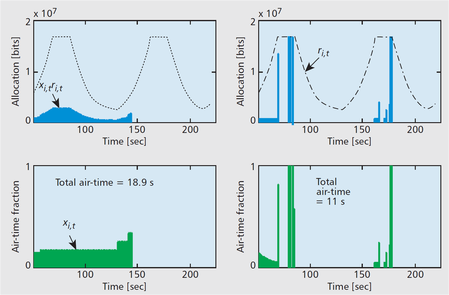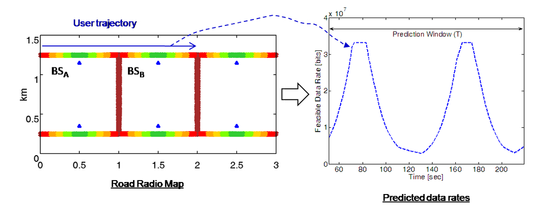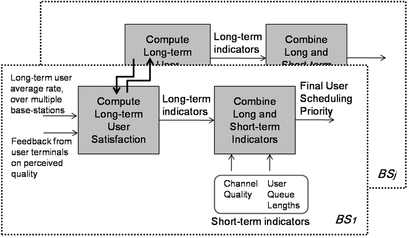Broadly, my research investigates how to optimize content delivery to mobile users by leveraging location information.
The objective is to proactively plan long-term delivery and storage/caching mechanisms at the various network layers to 1) improve user QoS, and 2) improve network efficiency and power consumption. Most of my work focused on the delivery of stored videos and HTTP-based adaptive streaming, but similar predictive approaches can be applied to other forms of non real-time content (that can be strategically pushed to user devices).
The objective is to proactively plan long-term delivery and storage/caching mechanisms at the various network layers to 1) improve user QoS, and 2) improve network efficiency and power consumption. Most of my work focused on the delivery of stored videos and HTTP-based adaptive streaming, but similar predictive approaches can be applied to other forms of non real-time content (that can be strategically pushed to user devices).
Enhancing End-to-End Video Delivery by Looking-ahead at User Mobility
 Figure 1. Potential of location-awareness to optimize end-to-end video delivery.
Figure 1. Potential of location-awareness to optimize end-to-end video delivery.
The phenomenal growth of mobile video has led researchers and industry to seek novel disruptive paradigms for media delivery. Since much of this content is non real-time, there is ample room to optimize it's end-to-end delivery by exploiting user location-awareness and mobility predictions, as illustrated in Figure 1. This includes 'smarter' 1) caching, 2) content pre-fetching, 3) radio resource allocation and 4) video quality planning. For example, if the radio map indicates that a user's future signal strength will be low, then extra radio resources can be granted to pre-buffer additional content. Furthermore, if the next cell is congested, then (a large number of) lower quality segments will be quickly delivery to prevent future video stalls.
Current work focused on developing a cross-layer framework that jointly optimizes multi-user radio access and long-term quality planning of adaptive video streaming. We first modeled and formulated the problem as a mixed-integer linear program (MILP) and then developed close to optimal polynomial-time algorithms. Effects of prediction errors and stochastic formulations incorporating uncertainty are currently being addressed.
Current work focused on developing a cross-layer framework that jointly optimizes multi-user radio access and long-term quality planning of adaptive video streaming. We first modeled and formulated the problem as a mixed-integer linear program (MILP) and then developed close to optimal polynomial-time algorithms. Effects of prediction errors and stochastic formulations incorporating uncertainty are currently being addressed.
Publications:
- Towards Green Media Delivery: Location-Aware Opportunities and Approaches [paper]
H. Abou-zeid and H.S. Hassanein
IEEE Wireless Communications Magazine, Aug. 2014. - Jointly Optimizing Resource Allocation and Quality for Wireless Video Streaming Using Rate Prediction
H. Abou-zeid, H.S. Hassanein and S. Valentin
IEEE Transactions on Vehicular Technology, June 2014. - Enhancing Mobile Video Streaming by Lookahead Rate Allocation in Wireless Networks [paper] [slides]
H. Abou-zeid, H.S. Hassanein and N. Zorba
IEEE Consumer Communications and Networking Conference (CCNC), Jan. 2014.
Predictive Green Wireless Access: Exploiting Mobility and Application Information
 Figure 2. Operations and information exchange in predictive wireless access.
Figure 2. Operations and information exchange in predictive wireless access.
The increasing mobile data traffic and dense deployment of wireless networks have made energy efficient radio access imperative.
As networks are designed to satisfy peak user demands, radio access energy can be reduced significantly at times of lower demand. This includes putting base stations (BSs) to intermittent short sleep modes,
as well as powering down select BSs completely where demand is low for prolonged time periods. In order to fully exploit such energy conserving mechanisms, networks should be aware of the user temporal and spatial traffic demands which is what we address in this project. To this end, we:
As networks are designed to satisfy peak user demands, radio access energy can be reduced significantly at times of lower demand. This includes putting base stations (BSs) to intermittent short sleep modes,
as well as powering down select BSs completely where demand is low for prolonged time periods. In order to fully exploit such energy conserving mechanisms, networks should be aware of the user temporal and spatial traffic demands which is what we address in this project. To this end, we:
- propose an architecture for a predictive green wireless access (PreGWA) framework and identify its key functional entities and their interaction/signalling requirements,
- apply the predictive access schemes to improve the transmission efficiency of stored videos through algorithms that incorporate rate predictions. We also minimize downlink BS transmission power for HTTP-based adaptive video streaming. BS on-off switching patterns are developed based on traffic and user location-awareness,
- develop simple distributed multi-cell resource allocation solutions, and highlight the need for and user equipment assistance (e.g. by reporting video buffer status during handover).
 Figure 3. Illustration of air-time minimization using rate predictions.
Figure 3. Illustration of air-time minimization using rate predictions.
Publications:
- Energy Efficient Adaptive Video Transmission: Exploiting Rate Predictions in Wireless Networks [paper]
H. Abou-zeid, H.S. Hassanein and S. Valentin
IEEE Transactions on Vehicular Technology, Jun. 2014. - Predictive Green Wireless Access: Exploiting Mobility and Application Information [paper]
H. Abou-zeid and H.S. Hassanein
IEEE Wireless Communications Magazine. Special Issue on Cooperative and Cognitive paradigms for Green HetNets, Oct. 2013. - Efficient Lookahead Resource Allocation for Stored Video Delivery in Multi-Cell Networks [paper]
H. Abou-zeid and H.S. Hassanein
IEEE Wireless Communications and Networking Conference (WCNC), Apr. 2014.
Long-term Resource Allocation Plans using Rate Predictions in Multi-cell Networks
 Figure 4. Predicting data rates by mapping a user trajectory on to a road radio map.
Figure 4. Predicting data rates by mapping a user trajectory on to a road radio map.
Resource Allocation (RA) in cellular networks is a challenging problem due to the demanding user requirements and limited network resources. Moreover, mobility results in channel gains that vary significantly with time. In particular, vehicular users traversing small cells experience significant service fluctuations. However, since location and received signal strength are correlated, user mobility patterns can be exploited to predict the data rates they will experience in the future. In this research we show that with such predictions, long-term RA plans spanning multiple cells can be made. We investigate how system throughput and user fairness can be improved and propose a predictive proportional fair (PPF) allocator that uses a long-term version of the alpha-fair utility function. The architecture and methods resulted in a patent filing by Alcatel-Lucent.
Publications:
- Optimal Predictive Resource Allocation: Exploiting Mobility Patterns and Radio Maps [paper]
H. Abou-zeid, H.S. Hassanein, and S. Valentin
IEEE Global Communications Conference (GLOBECOM), Dec. 2013. - Long-term Fairness in Multi-cell Networks Using Rate Predictions [paper]
H. Abou-zeid, H.S. Hassanein and N. Zorba
IEEE GCC Conference and Exhibition (GCC), Nov. 2013. - Apparatus, methods, and computer programs for a mobile transceiver and for a base station transceiver
H. Abou-zeid, S. Valentin, and H.S. Hassanein
EP Patent App. 20110306323, filed by Alcatel-Lucent, Oct. 2011.
Lookback Scheduling for Long-term Multi-cell QoS Provisioning
 Figure 5. The proposed Long-term Lookback Scheduling (LLS) framework.
Figure 5. The proposed Long-term Lookback Scheduling (LLS) framework.
In current cellular networks, schedulers allocate wireless channel resources to users based on instantaneous channel gains and short-term moving averages of user rates and queue lengths. By using only such short-term information, schedulers ignore the users’ service history in previous cells and, thus, cannot guarantee long-term Quality of Service (QoS) when users traverse multiple cells with varying load and capacity. To this end, in this research we proposed a new Long-term Lookback Scheduling (LLS) framework, which extends conventional short-term scheduling with long-term QoS information from previously traversed cells. We demonstrated the application of LLS for common channel-aware, as well as channel and queue-aware schedulers. The developed LLS schedulers also provide a controllable trade-off between emphasizing the immediate user QoS or the long-term measures. The results of this work showed high gains in long-term QoS without sacrificing short-term user requirements, and led to a patent filing by Alcatel-Lucent.
Publications:
- A Lookback Scheduling Framework for Long-term Quality-of-Service over Multiple Cells [paper]
H. Abou-zeid, H.S. Hassanein, S. Valentin and M.F. Feteiha
Wireless Commun. and Mobile Comp., submitted Nov. 2013 [invited]. - Lookback Scheduling for Long-Term Quality-of-Service over Multiple Cells [paper] [slides]
H. Abou-zeid, H.S. Hassanein, S. Valentin and M. Feteiha
IEEE International Wireless Communication and Mobile Computing Conference (IWCMC), July 2013. - Long-term Proportional Fairness Over Multiple Cells [paper]
H. Abou-zeid, S. Valentin, and H.S. Hassanein
IEEE International Workshop on Wireless Local Networks, collocated with IEEE LCN, Oct. 2012.